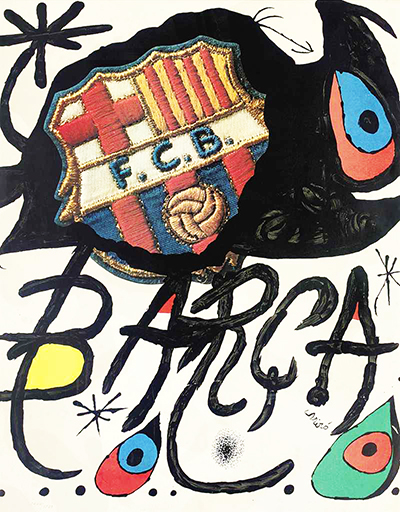Joan Miro's Barcelona painting is one of this artist's most famous works. Football fans in Barcelona and right around the globe may be more familiar with this one than with any other, since it commemorates the achievements of Barcelona Football Club.
The painting, which is also known as, "Futbol Club Barcelona", was completed in 1974. As a dedicatory notice for FC Barcelona's 75th commemoration (1974), it combines the symbols which are normally associated with the team and the artist's own distinctive handwriting. The creation also consolidates Miró's trademark signs and lines with the Catalan group's peak. The word Barça swirls across the centre of the painting in the craftsman's own penmanship. La Polígrafa's print count for the first publication was 50,000 duplicates as many excited fans made sure they had their own individual copy. La Vanguardia ran a story on the history of Miró's publication on 12 May 1974. This took place soon after FC Barcelona had won La Liga that season.
The original painting from Joan Miró done in 1974 for Futbol Club Barcelona was imprinted in different versions. One has more than 1500, every one of them numbered, with the football club's stamp, the time of the version and other important distinguishing information, such as Miró's mark. Joan Miro was a multi talented artist. He was a Spanish painter, stone carver, etcher and ceramist. He is also considered one of the real delegates of Surrealism. His work mirrors the enthusiasm for intuitive ideas, the puerile perspective and his nation. In many meetings and articles dated from 1930 and 1940, Miró communicated his expectation to leave customary painting.
He actually stated that he wanted to slaughter it. His aim was to murder traditional painting or to damage it, keeping in mind the end goal to support a method for expression that could truly be thought of as contemporary. He utilised a wide range of strategies of painting, some of them extremely unique. His paintings are created with oil, casein, egg, lacquer and tar. Some frequently feature an arrangement of cardboard and paper with sand. Miro dove deep into the realistic generation when he was at that point a renowned craftsman with enormous involvement in work created with various materials and new strategies. He took in etching in Louis Marcoussis' studio beginning first with two plates for two unique hues.
Amid his stay in New York he enhanced his method. He developed a new way of using shading in his compositions that influenced his later work. At the point when Miró returned to Europe, he began to team up with writers who were his companions, partaking in book representation. In works done during what is considered his late period we can see the impact of North American painting and his enthusiasm for Japanese calligraphy. His realistic craftsmanship and vision highly influenced his artistic creations. Miro was associated with many famous creative people and celebrities of that time, including Sala Gaspar. In fact, a truly close and warm fellowship existed between Miró and the entire Gaspar family.





